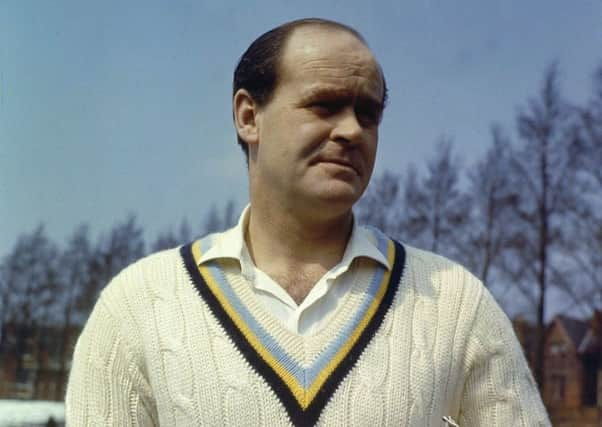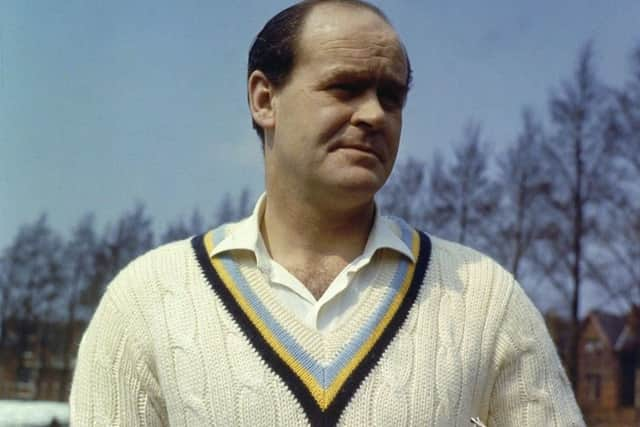Brian Close: Tribute to a Yorkshire legend


YORKSHIRE has produced scores of hugely-talented sportsmen who excelled in various disciplines but Dennis Brian Close was surely unique even in such company.
It was as a cricketer and a captain in particular that Close will be remembered with appreciation verging on awe but he was also a professional footballer, a formidable tennis and squash player, a trophy-winning boxer, good enough at snooker and billiards to take on – and occasionally beat – professionals and a golfer with the God-given ability to play to a handicap of two left-handed and six right-handed.
Advertisement
Hide AdAdvertisement
Hide AdThe statistics reveal only the bones of the Close story. He captained Yorkshire from 1963 to 1970, winning the County Championship four times, the one-day Gillette Cup twice; he played 22 Tests for England, seven of them as captain with a record of six wins and a draw.


He made his Yorkshire debut in 1949 – along with Frank Lowson and Fred Trueman – and amazingly achieved the double of 1,000 runs and 100 wickets that season. He played 536 times for Yorkshire, scoring 22,560 runs, including 33 centuries, at an average of 31.94, taking 967 wickets at 24.29 and holding 564 catches. For England he made 887 (25.31), took 18 wickets (29.55) and claimed 24 catches.
Talented he undoubtedly was, but he was also courageous, stubborn, flamboyant, principled, sensitive, intelligent, intuitive and generous. It was a mix which brought him happy times and times of desperate sadness, which made him a man easy to admire but also, if inclination demanded, a man easy to criticise.
Advertisement
Hide AdAdvertisement
Hide AdBrian Close was born into a cricketing family in Rawdon on February 24, 1931 and by the age of 11 was playing in the village club’s first XI in the Airedale-Wharfedale League. A left-handed batsman and right-arm swing then off-spin bowler, Close shone at football and cricket during his years at Aireborough Grammar School – which had earlier produced Hedley Verity – and was also academically successful, qualifying for a university place at 17.
He signed professional forms with Leeds United on leaving school and cricket was his second sport when as, as a shy but powerful young man, he first played for Yorkshire against Cambridge University in 1949.
He was picked, at 18 years and 149 days old, to play for England in the third Test of that summer against New Zealand at Old Trafford, taking one wicket for 85 runs and, under orders to score quickly, was caught on the boundary for a duck. He remains the youngest cricketer to play for England.
The following year he began his National Service in the Royal Signals and had played only once for Yorkshire when he was picked for Freddie Brown’s MCC party to tour Australia. That was a harrowing experience for the young man.
Advertisement
Hide AdAdvertisement
Hide AdIgnored by many of the senior players, some of whom thought he was making more than he should of a niggling injury, Close spent the whole winter wondering why he was there and later confessed to having been so depressed that, on several occasions, he pondered suicide.
On his return, his footballing career saw him transferred from Leeds United to Arsenal then, in 1952, he achieved his second cricketing “double” of wickets and runs before a knee injury suffered while playing football for his latest club Bradford City condemned him to 18 months of recuperation. His professional football career was over.
He began the 1954 cricket season playing purely as a batsman but later resumed bowling and by the time the spring of 1955 came he was at last fully fit and ready to resume a cricket career which had begun so promisingly.
Yorkshire’s dressing room at that time was not a happy place, although the team included several top-quality players, and it was not until 1958 when Ronnie Burnet, an amateur who had been playing for Baildon in the Bradford League and captaining Yorkshire Colts, took charge of the senior side that Yorkshire once again became the best team in the land.
Advertisement
Hide AdAdvertisement
Hide AdBurnet introduced some of the young players he had led in the Colts and some of the “old guard” moved on. Progress was quickly made, the Championship being won in 1959 and again, by now with the long-serving batsman Vic Wilson as captain, in 1960 and 1962.
When Wilson retired, Close took over the captaincy for the 1963 season and duly led the side to another success which was followed by others in 1966, 1967 and 1968. The Gillette Cup was won in 1965 and 1969.
With a core of great players – Close himself, Trueman, Raymond Illingworth and Geoffrey Boycott – plus a stream of extremely good ones, like Jimmy Binks, Ken Taylor, Tony Nicholson, Phil Sharpe, Doug Padgett, Don Wilson, John Hampshire and Richard Hutton, Yorkshire were the team everyone wanted to beat and Close made it his over-riding mission to make sure the opposition rarely enjoyed that sensation. That was to cost him dear.
His England career had stuttered since that early unsuccessful Australian tour – one sound critic suggested his undoubted talent was undone by over-confidence – but he became a national hero in 1963 when he saved and almost won a Test match against the West Indies and took a fearful battering in the process.
Advertisement
Hide AdAdvertisement
Hide AdEngland needed 234 to win with a day and half remaining of the Lord’s Test of that year against an attack led, on a helpful wicket, by Charlie Griffith and Wes Hall, two of the fastest bowlers in the game’s history. Three wickets were quickly lost and Colin Cowdrey suffered a broken arm before Close joined Ken Barrington in a stand which saw England to the end of a day shortened by bad light.
Barrington fell when play resumed after lunch in heavily-overcast conditions the following day but Close, supported by Jim Parks and Fred Titmus, continued his defiant innings. Eventually, as he ran out of partners, Close changed tack and began charging down the wicket, swinging aggressively at Griffith and Hall. They responded by dropping the ball ever shorter and repeatedly hitting the oncoming Close, who was finally beaten when he edged to the wicket-keeper.
Cowdrey emerged as last man, arm in plaster, to stand at the non-striker’s end while the last over was played out by David Allen and England had escaped but, to Close’s chagrin, they were only six runs short of victory.
Next day he was back on Yorkshire duty at Bramall Lane to face Glamorgan, a photograph taken before play showing his body covered by 14 weals where he had taken the fastest the West Indies could bowl at him. His autobiography, published in 1978, was wryly entitled I Don’t Bruise Easily. He overcame the stiffness to take 10 wickets in the match for 74 and score 61 as Yorkshire won by 10 wickets.
Advertisement
Hide AdAdvertisement
Hide AdWhen the West Indies toured again three years later, under Gary Sobers, they led the series 3-0 with one match drawn and, for the final Test, Close replaced Cowdrey as captain. He insisted on picking Illingworth and inspired his team to victory by an innings and 34 runs.
His reward was to lead England the following summer; India were beaten 3-0 and Pakistan 2-0 and he was the obvious choice to captain the team in the West Indies that winter.
Instead he did not play for England again until 1976. What had gone wrong?
Close had apparently been advised to keep out of mischief as tour selection for the Caribbean approached but the advice went unheeded when he led Yorkshire in a crucial championship match against Warwickshire at Edgbaston in August 1967. Yorkshire needed victory to overhaul Kent at the top of the table but when they were dismissed cheaply on the last day the home side were left to score 142 to win in 102 minutes.
Advertisement
Hide AdAdvertisement
Hide AdThere was a persistent drizzle and Yorkshire’s pace bowlers had to constantly use a towel to dry the ball; the rising buzz of anticipation from the crowd meant Close’s instructions to his wide-spread field could not be heard and had to be repeated. Yorkshire bowled just six overs in the final 30 minutes and were accused of time-wasting.
Trueman’s car was damaged at the ground and Close was accused, erroneously, as Warwickshire later confirmed, of having an altercation with a member. Close was called to a disciplinary hearing at Lord’s where he was censured as being responsible for tactics which were “against the best interests of the game”.
The selection panel, under chairman Doug Insole, wanted him to continue as England’s captain but were over-ruled by the full committee of the then all-powerful MCC who were perhaps influenced by the anti-Close stance taken by a majority of the London-based cricket correspondents.
Close returned to Yorkshire and England later left for the West Indies without him, Cowdrey returning as captain, but things were changing on home ground. Leading players had left or retired, youngsters were having to be introduced and one-day competitions – “workshop cricket” Close called it – were increasingly popular.
Advertisement
Hide AdAdvertisement
Hide AdStill, Close’s “new” Yorkshire finished a creditable fourth in the 1970 championship and he was looking forward to a new season that November when he was unexpectedly called to Headingley and told by the cricket chairman, the formidable Brian Sellers, that he faced a choice: resign or be sacked over his persistent public criticism of the one-day game.
Close was devastated. He had given 22 years to Yorkshire and they had given him a matter of hours to decide on the manner of his leaving. He chose not to resign, reasoning that to do so would be to break faith with those who had supported his testimonial that summer.
He was sacked, Boycott was appointed as successor and so began a period of internal bickering which was to blight Yorkshire cricket for years to come. Close himself was far away, inspiring perennial also-rans Somerset to become challengers for honours, playing a fatherly role in the development of the young Ian Botham and even scoring a century against his former county.
That 1976 series against the West Indies was to prove his international swansong. Yet it would also provide some of the most iconic images of his career.
Advertisement
Hide AdAdvertisement
Hide AdHis split-second evasion of a series of ferocious bouncers – delivered by the likes of Michael Holding at 90mph and aimed at the head in an era before the use of helmets – exemplified his bravery and is still acknowledged as one of the finest displays of courage ever to have been seen on a cricket field. It was to be his final Test innings.
On retirement in 1977, when he was awarded a CBE for his services to cricket, he joined the warring Yorkshire committee and, along with Bob Appleyard, played an important role in the founding of the Yorkshire Academy and leading the campaign for first-class cricket to continue at Bradford’s Park Avenue ground.
He continued his life-long fascination for cricket, playing until well into his fifties, and to the end was never short of an opinion on the game’s issues of the day.
He defied the sport-induced aches and pains of later years to remain a competitive golfer, organising many tournaments for charity, and never lost his passionate interest in horse-racing, although he was first to admit that his selections were not always the wisest. He was appointed CBE in 1972 and was also made an honorary life member of the county club, as well as becoming President of the Yorkshire Players’ Association.
He is survived by his widow, Vivienne, their son, Lance, and daughter, Lyn.